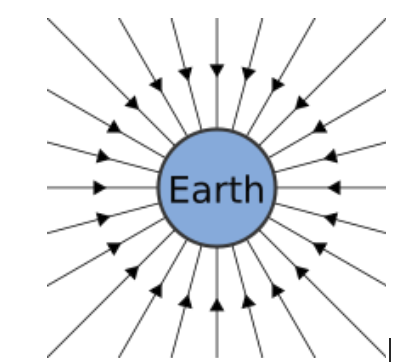Daniella Garcia-Loos
Erin Brzusek
AP Physics 1 🎡
257 resourcesSee Units
Gravitational Fields and Weight⬇️
A gravitational field g at the location of an object with mass m causes a gravitational force of magnitude mg to be exerted on the object in the direction of the field.
Equation: F = mg

Image Courtesy of tes.com
Weight, or force of gravity, is a force that acts on all objects near Earth. As pictured in the image above, Weight is always acting downwards towards the center of the Earth. The acceleration due to gravity on Earth, or g, is equal to 9.81 m/s/s; however, it is acceptable on the AP Physics 1 exam to substitute in 10 m/s/s for the acceleration due to gravity.
With this knowledge, you can use an object’s mass in kilograms to find its weight utilizing the equation F = mg. If this is the only force exerted on an object, the object is said to be in free fall. If you recall from Kinematics, an object’s acceleration is equal to 9.8 m/s/s when it is in free fall.
Key Concept: Weight - the Force of Gravity experienced by an object, changes depending on the relative location to Earth’s surface or other planets
- SI Unit: Newtons
Key Concept: Mass - a measure of the inertia of an object, stays the same regardless of location
- SI Unit: Kilograms
Weight is often confused with mass, but they are not the same thing. Mass is a measure of the amount of matter in an object, while weight is a measure of the force exerted on an object due to gravity. The mass of an object remains the same no matter where it is, but its weight will change depending on the strength of the local gravitational field.
Here are some key points about weight and gravitational fields:
- Mass is a measure of the amount of matter in an object, while weight is a measure of the force exerted on an object due to gravity.
- The mass of an object remains the same no matter where it is, but its weight will change depending on the strength of the local gravitational field.
- A gravitational field is the region around a massive object in which other objects experience a force of attraction due to the mass of the first object.
- The strength of a gravitational field is determined by the mass of the object and its distance from other objects.
- The gravitational field of a planet or other celestial body extends throughout the universe, but the strength of the field decreases with distance from the object.
- The gravitational field of the Earth is what gives objects their weight.
Example Problem #1:
A 5.00-kg object is placed on a frictionless table. Determine the gravitational force on the object due to Earth if the acceleration due to gravity is 9.8 m/s^2.
To solve this problem, you can use the equation F=mg, where F is the gravitational force, m is the mass of the object, and g is the acceleration due to gravity. Plugging in the given values, we get:
F = (5.00 kg)(9.8 m/s^2) = 49 N
So the gravitational force on the object is 49 N. Keep in mind that this problem assumes that the object is at rest and is not moving. If the object is in motion, other forces may also be acting on it and you would need to take them into account in order to determine the total force acting on the object.
Example Problem #2:
A scientist is studying the behavior of a new type of material on different planets. She places a 10.0 g sample of the material on the surface of Planet X, which has a mass of 5.00 x 10^23 kg and a radius of 6.38 x 10^6 meters. The acceleration due to gravity on Planet X is 8.87 m/s^2. Calculate the gravitational force acting on the sample.
To solve this problem, we first need to determine the mass of the sample in kilograms. We can do this by using the formula m = m(g)/1000, where m(g) is the mass in grams and 1000 is the conversion factor from grams to kilograms. Plugging in the given value, we have:
m = (10.0 g)/1000 = 0.01 kg
Next, we can use the formula F = mg to calculate the gravitational force acting on the sample. Plugging in the values, we have:
F = (0.01 kg)(8.87 m/s^2) = 0.09 N
Therefore, the gravitational force acting on the sample is 0.09 N.
Example Problem #3:
A student is studying the weight of a textbook. The textbook has a mass of 2.00 kg and the acceleration due to gravity is 9.80 m/s^2. Calculate the weight of the textbook in newtons and in pounds.
To solve this problem, we can use the formula F = mg, where F is the weight of the object, m is the mass of the object, and g is the acceleration due to gravity. Plugging in the given values, we have:
F = (2.00 kg)(9.80 m/s^2) = 19.6 N
To convert the weight to pounds, we can use the conversion factor 1 N = 0.225 pounds. Plugging in the value for the weight in newtons, we have:
Weight (pounds) = (19.6 N)(0.225 pounds/N) = 4.42 pounds
Browse Study Guides By Unit
👟Unit 1 – Kinematics
🌀Unit 2 – Dynamics
🚀Unit 3 – Circular Motion & Gravitation
⚡️Unit 4 – Energy
⛳️Unit 5 – Momentum
🎸Unit 6 – Simple Harmonic Motion
🎡Unit 7 – Torque & Rotational Motion
💡Unit 8 – Electric Charges & Electric Force
🔋Unit 9 – DC Circuits
🔊Unit 10 – Mechanical Waves & Sound
📚Study Tools
🧐Exam Skills

Fiveable
Resources
© 2025 Fiveable Inc. All rights reserved.